Solar geoengineering is a type of climate intervention: deliberate actions designed to affect the climate. There are several ways to try to reduce the amount of sunlight reaching the surface of the earth and all of them are controversial. Perhaps the least controversial approach is cloud brightening.
The idea is based on something called the Twomey effect, which is that large numbers of small droplets in the atmosphere reflect more sunlight than small numbers of large droplets. Spraying vast quantities of minuscule aerosols into the sky, thereby forming many small droplets, could change the reflective properties of clouds. If clouds are more reflective, then less sunlight reaches the surface, and the temperature goes down.
This form of geoengineering is thought to be less risky because it can be performed on a localized basis and can use relatively benign materials such as sea salt.
In early April, scientists from the University of Washington started testing a device that sprays tiny sea-salt particles into the air from the deck of a decommissioned aircraft carrier in Alameda, California. The test was simply to see whether the machine propelled a mist of suitable size.
Within two weeks, Alameda officials ordered a stop to the experiment, citing potential health and environmental risks. After a month-long investigation, Alameda ruled that the experiment does not generate a measurable risk to health, wildlife, or the environment.
But before more ambitious experiments take place, there are potential side effects of cloud brightening that need to be studied. It may turn out to be a useful tool in fighting global warming, but in any case, such technology should not be viewed as a substitute for moving away from fossil fuels.
**********
Web Links
A Test of Cloud-Brightening Machines Poses No Health Risk, Officials Say
Photo, posted September 8, 2011, courtesy of Justin Ladia via Flickr.
Earth Wise is a production of WAMC Northeast Public Radio









